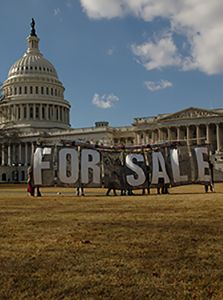This post first appeared at The Hill.

US Capitol For Sale protest in Washington, DC. (Photo by takomabibelot/flickr CC 2.0)
Company leaders dipped into Chevron’s corporate coffers and handed over $1 million in a single campaign contribution to the US House of Representatives’ Republican super PAC, the Congressional Leadership Fund. The super PAC used Chevron’s money and other funds it raised to launch thousands of TV campaign ads attacking 16 congressional Democrats and one Independent across the country, ranging from gun control advocate Ron Barber in Arizona to conservative Democrat Colin Peterson in Minnesota.
The problem: Chevron is a government contractor, and federal law prohibits federal contractors from making campaign contributions to candidates, parties and political committees, including super PACs.
Pay-to-play is the all-too-common practice of a business entity making campaign contributions to a public official with the hope of gaining a lucrative government contract. Rarely does pay-to-play constitute outright bribery for a government contract. Rather, pay-to-play usually involves a business entity endearing itself and buying access for consideration of a government contract. It often results in wasted taxpayer dollars as contracts are awarded based on politics rather than merit, and can cause legitimate businesses to think twice about engaging in government services, which is why the federal government and 15 states restrict campaign contributions from government contractors.
The federal pay-to-play law reads in part: “It shall be unlawful for any person … who enters into any contract with the United States … to make any such contribution to any political party, committee, or candidate for public office or to any person for any political purpose or use….” (2 USC 441c). The Congressional Leadership Fund is fully aware of the law and even posts on its website that “Contributions from foreign nationals, Federal government contractors, national banks, or corporations organized by act of Congress are prohibited.”
The catch: The FEC, the agency charged with enforcing the law, ruled in a complaint filed against Chevron by Public Citizen regarding a similar $2.5 million contribution to the same super PAC in 2012, that as long as Chevron creates separate legal entities within the same corporate family – even if only on paper – a Chevron entity that does not itself receive a government contract may tap into the corporate treasury for making campaign contributions on behalf of the company. In this case, the Chevron Policy, Government & Public Affairs division doles out a million dollars in campaign contributions, while Chevron USA rakes in billions of dollars in government contracts.
The FEC has created a loophole a million dollars wide for federal contractors to exploit. Any company can easily establish artificial legal distinctions among its subsidiaries and divisions, so that one division endears the company to federal officials via campaign contributions while another is rewarded with lucrative government contracts.
Though most federal contractors comply with the law, the green light for evasion from the FEC has prompted a handful of federal contractors to begin joining Chevron in the pay-to-play system for winning government contracts. If this loophole is not closed, pay-to-play abuse will rapidly expand among wealthy corporations that can afford buying advantage in the competition for taxpayer-funded contracts.
Chevron may well believe that the US Supreme Court’s 2010 Citizens United decision, which allows unlimited corporate expenditures in elections, also gutted the pay-to-play law. It did not. The courts thus far have been very protective of pay-to-play laws. As early as the 1995 Blount v. SEC decision and more recently in the 2010 Green Party of Connecticut v. Garfield decision, the courts have recognized the grave potential for corruption in government contracting and have upheld pay-to-play laws and rules as narrowly tailored remedies to a very real and specific problem. Pay-to-play restrictions are not campaign finance reforms; they are government contracting reforms.
The FEC should follow suit and re-evaluate its artificial distinction between entities of the same corporate family. Other federal agencies and the courts have applied much more exacting and accurate standards for “piercing the veil” and determining whether contractors and subsidiaries wholly or partially owned by a corporation are treated as a single business enterprise subject to the same regulations.
If the FEC fails to close the million-dollar loophole it poked into the federal pay-to-play law, the integrity of the government contracting process is in dire risk – and so, too, will be our taxpayer dollars.
The views expressed in this post are the author’s alone, and presented here to offer a variety of perspectives to our readers.


